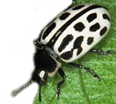The Click beetle Lacon querceus (HERBST, 1784) |
Text © Klaas Reißmann, 2010
|
|
|
1. Distribution |
|
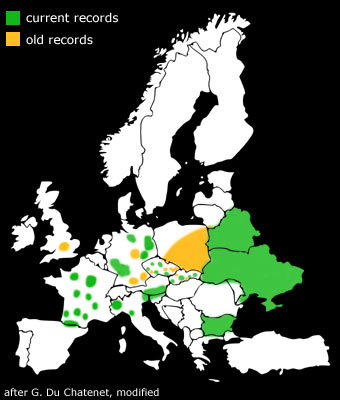
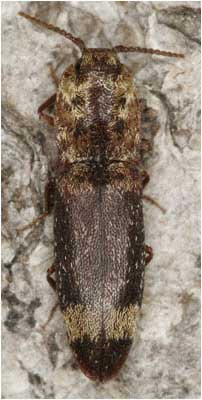 The Click beetle Lacon querceus is probably one of the most beautiful representatives of the family Elateridae, but at the same time one of the
rarest species of the German fauna. Its natural range stretches from the Pyrenees in the southwest over France, Central Europe, and the northern
part of Southern Europe to Western Siberia in Russia. Throughout its whole range the species is not widespread, but occurs only insular and isolated.
Even in areas with known populations it is very difficult to provide evidence for the occurrence of the beetles due to their crepuscular and nocturnal
lifestyle and the fact, that the beetles stay in and on their brood substrate most of the time. The only record from England, the almost historic
1936-discovery by ALLEN from Windsor Forest, gives an idea how rare the species and how insular its distribution really is (the species is classified
as missing or extinct in England). There are records from the following European countries: France, England (only historical records - species missing
or extinct), Germany, Southern Sweden (historical), northern parts of Switzerland (historical), Italy, Austria (only in the east), Poland (historical),
Czech Republic, Slovakia, Slovenia, Bulgaria, Ukraine and Western Russia. Recent records from Germany are from Baden-Württemberg,
Hesse, Rhineland-Palatinate, Lower Saxony (Lower Elbe region), Brandenburg and Saxony. There are only historical records from Bavaria (before 1950),
Lower Saxony (Hannover region - before 1900) and Thuringia (before 1950). The species was never recorded from any other area in Germany.
The Click beetle Lacon querceus is probably one of the most beautiful representatives of the family Elateridae, but at the same time one of the
rarest species of the German fauna. Its natural range stretches from the Pyrenees in the southwest over France, Central Europe, and the northern
part of Southern Europe to Western Siberia in Russia. Throughout its whole range the species is not widespread, but occurs only insular and isolated.
Even in areas with known populations it is very difficult to provide evidence for the occurrence of the beetles due to their crepuscular and nocturnal
lifestyle and the fact, that the beetles stay in and on their brood substrate most of the time. The only record from England, the almost historic
1936-discovery by ALLEN from Windsor Forest, gives an idea how rare the species and how insular its distribution really is (the species is classified
as missing or extinct in England). There are records from the following European countries: France, England (only historical records - species missing
or extinct), Germany, Southern Sweden (historical), northern parts of Switzerland (historical), Italy, Austria (only in the east), Poland (historical),
Czech Republic, Slovakia, Slovenia, Bulgaria, Ukraine and Western Russia. Recent records from Germany are from Baden-Württemberg,
Hesse, Rhineland-Palatinate, Lower Saxony (Lower Elbe region), Brandenburg and Saxony. There are only historical records from Bavaria (before 1950),
Lower Saxony (Hannover region - before 1900) and Thuringia (before 1950). The species was never recorded from any other area in Germany.
|
2. Determination |
|
Lacon querceus is one of a total of three species of the genus Lacon recorded from Germany. There are only historical records for the other two species,
Lacon punctatus and Lacon lepidopterus, from the first half of the 20th century from Bavaria. Both species cannot be confused with Lacon querceus.
But the very similar species Danosoma (Lacon) fasciata is still recorded from Bavaria, Saxony-Anhalt and Saxony and historically (before 1950) from
Thuringia. The distinction between these two species is not easy, so that confusions are possible, but Danosoma fasciata is 14.5 to 18 mm large and
therefore much bigger than Lacon querceus, which is only 9 to 12 mm large.
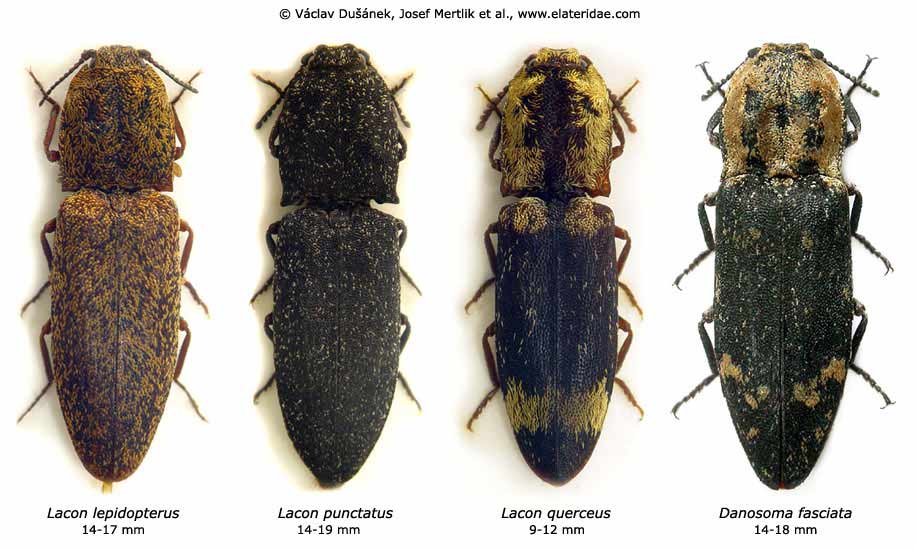
The three species of genus Lacon recorded in Germany (L. lepidopterus, L. punctatus, L. querceus) and Danosoma fasciata.
© Václav Dušánek, Josef Mertlik et al., www.elateridae.com, reproduction with written permission.
|
3. Life cycle |
|
The larvae of Lacon querceus develop almost exclusively in red-rotted oak wood (Quercus). Whether the tree is alive with large dead branches
or it is a hollow tree which is red-rotted or the tree is already dead, still standing or even fallen does not seem to be too important.
However, living trees and rather dry brood substrates seem to be preferred. If lying trees or branches are in contact with the ground and
start getting moist the already existing larvae can finish their development, but the substrate is no longer used by the beetles and the
population disappears within a short period of time. All red-rotted structures can be populated, stumps as well as trunks and big branches.
The larvae of Lacon querceus are predacious, their predominant prey are the larvae of the fungus beetle Mycetophagus piceus and a few other
insect larvae. Hence the dependency of red-rotted wood is indirect.
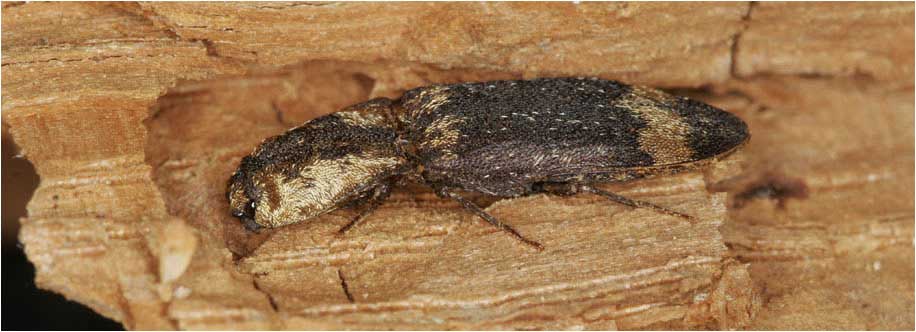 In oaks, red rot is normally caused by the fungus Laetiporus sulphureus. The mycelium of the fungus growing in the wood destroys the cellulose first
and leaves the lignin, which produces the noticeable red color and the characteristic die-break structure of the wood. The larvae of Mycetophagus
piceus develop in such red-rotted wood structures feeding on the mycelium of Laetiporus sulphureus. This in turn attracts Lacon querceus as their predator.
Lacon querceus pupates in summer in its brood substrate. The larva builds a puparium in which the pupa rests till September. In September the young
beetles can be found in their puparium where they hibernate. From Mai to June the beetles can be recorded in and on the breeding substrate. The
beetles are active fliers and can populate suitable habitats easily.
In oaks, red rot is normally caused by the fungus Laetiporus sulphureus. The mycelium of the fungus growing in the wood destroys the cellulose first
and leaves the lignin, which produces the noticeable red color and the characteristic die-break structure of the wood. The larvae of Mycetophagus
piceus develop in such red-rotted wood structures feeding on the mycelium of Laetiporus sulphureus. This in turn attracts Lacon querceus as their predator.
Lacon querceus pupates in summer in its brood substrate. The larva builds a puparium in which the pupa rests till September. In September the young
beetles can be found in their puparium where they hibernate. From Mai to June the beetles can be recorded in and on the breeding substrate. The
beetles are active fliers and can populate suitable habitats easily.
|
4. Observation |
|
It is quite difficult to observe the beetles. First of all, suitable structures like red-rotted hollow trees, red-rotted trunks, branches or
stumps should be identified. The larger dimensioned the substrate, the more likely it is to discover the beetles, because in the latter case the
population can be rather big and consist of several hundred individuals.
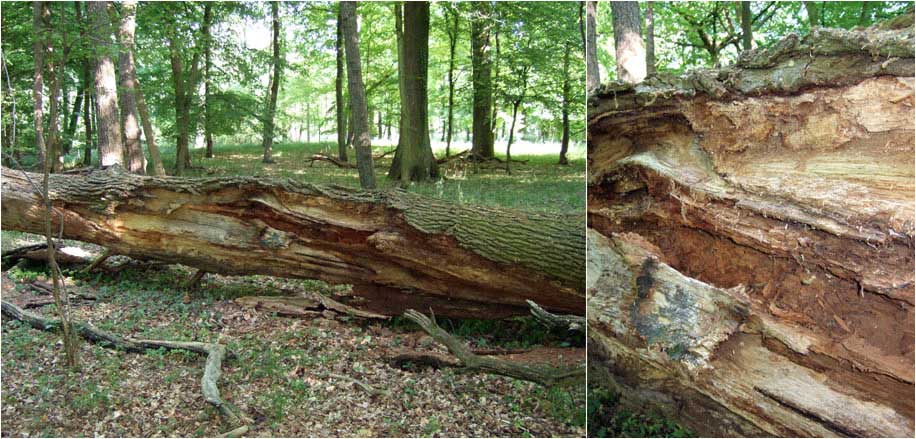 If the species is really present, it is easy to find the beetles from the beginning of September in their puparium. However, this normally means
destruction of rare brood substrate so it is good advice better not to search during wintertime for them, but to wait for Mai/June, when it is easy
to observe the beetles crawling around their brood substrate at night by using a torch light.
If the species is really present, it is easy to find the beetles from the beginning of September in their puparium. However, this normally means
destruction of rare brood substrate so it is good advice better not to search during wintertime for them, but to wait for Mai/June, when it is easy
to observe the beetles crawling around their brood substrate at night by using a torch light.
|
5. Red List |
|
Because of its rarity the species is classified in the Red List of Germany as critically endangered.
|
6. Sources |
Literature:
- BINOT, M. et al. (1998): Rote Liste gefährdeter Tiere Deutschlands
- BOEHME, J. (2005): Die Käfer Mitteleuropas, Katalog, 2nd edition
- CHATENET, du G. (2000): Coleopteres phytophages d'Europe
- KÖHLER, F. & B. KLAUSNITZER (1998): Verzeichnis der Käfer Deutschlands - Entomofauna Germanica, Dresden
- LOHSE, G. A. (1978) in FREUDE, H., HARDE, K. W., LOHSE, G. A.: Die Käfer Mitteleuropas, Diversicornia
|



 The Click beetle Lacon querceus is probably one of the most beautiful representatives of the family Elateridae, but at the same time one of the
rarest species of the German fauna. Its natural range stretches from the Pyrenees in the southwest over France, Central Europe, and the northern
part of Southern Europe to Western Siberia in Russia. Throughout its whole range the species is not widespread, but occurs only insular and isolated.
Even in areas with known populations it is very difficult to provide evidence for the occurrence of the beetles due to their crepuscular and nocturnal
lifestyle and the fact, that the beetles stay in and on their brood substrate most of the time. The only record from England, the almost historic
1936-discovery by ALLEN from Windsor Forest, gives an idea how rare the species and how insular its distribution really is (the species is classified
as missing or extinct in England). There are records from the following European countries: France, England (only historical records - species missing
or extinct), Germany, Southern Sweden (historical), northern parts of Switzerland (historical), Italy, Austria (only in the east), Poland (historical),
Czech Republic, Slovakia, Slovenia, Bulgaria, Ukraine and Western Russia. Recent records from Germany are from Baden-Württemberg,
Hesse, Rhineland-Palatinate, Lower Saxony (Lower Elbe region), Brandenburg and Saxony. There are only historical records from Bavaria (before 1950),
Lower Saxony (Hannover region - before 1900) and Thuringia (before 1950). The species was never recorded from any other area in Germany.
The Click beetle Lacon querceus is probably one of the most beautiful representatives of the family Elateridae, but at the same time one of the
rarest species of the German fauna. Its natural range stretches from the Pyrenees in the southwest over France, Central Europe, and the northern
part of Southern Europe to Western Siberia in Russia. Throughout its whole range the species is not widespread, but occurs only insular and isolated.
Even in areas with known populations it is very difficult to provide evidence for the occurrence of the beetles due to their crepuscular and nocturnal
lifestyle and the fact, that the beetles stay in and on their brood substrate most of the time. The only record from England, the almost historic
1936-discovery by ALLEN from Windsor Forest, gives an idea how rare the species and how insular its distribution really is (the species is classified
as missing or extinct in England). There are records from the following European countries: France, England (only historical records - species missing
or extinct), Germany, Southern Sweden (historical), northern parts of Switzerland (historical), Italy, Austria (only in the east), Poland (historical),
Czech Republic, Slovakia, Slovenia, Bulgaria, Ukraine and Western Russia. Recent records from Germany are from Baden-Württemberg,
Hesse, Rhineland-Palatinate, Lower Saxony (Lower Elbe region), Brandenburg and Saxony. There are only historical records from Bavaria (before 1950),
Lower Saxony (Hannover region - before 1900) and Thuringia (before 1950). The species was never recorded from any other area in Germany. In oaks, red rot is normally caused by the fungus Laetiporus sulphureus. The mycelium of the fungus growing in the wood destroys the cellulose first
and leaves the lignin, which produces the noticeable red color and the characteristic die-break structure of the wood. The larvae of Mycetophagus
piceus develop in such red-rotted wood structures feeding on the mycelium of Laetiporus sulphureus. This in turn attracts Lacon querceus as their predator.
Lacon querceus pupates in summer in its brood substrate. The larva builds a puparium in which the pupa rests till September. In September the young
beetles can be found in their puparium where they hibernate. From Mai to June the beetles can be recorded in and on the breeding substrate. The
beetles are active fliers and can populate suitable habitats easily.
In oaks, red rot is normally caused by the fungus Laetiporus sulphureus. The mycelium of the fungus growing in the wood destroys the cellulose first
and leaves the lignin, which produces the noticeable red color and the characteristic die-break structure of the wood. The larvae of Mycetophagus
piceus develop in such red-rotted wood structures feeding on the mycelium of Laetiporus sulphureus. This in turn attracts Lacon querceus as their predator.
Lacon querceus pupates in summer in its brood substrate. The larva builds a puparium in which the pupa rests till September. In September the young
beetles can be found in their puparium where they hibernate. From Mai to June the beetles can be recorded in and on the breeding substrate. The
beetles are active fliers and can populate suitable habitats easily.
 If the species is really present, it is easy to find the beetles from the beginning of September in their puparium. However, this normally means
destruction of rare brood substrate so it is good advice better not to search during wintertime for them, but to wait for Mai/June, when it is easy
to observe the beetles crawling around their brood substrate at night by using a torch light.
If the species is really present, it is easy to find the beetles from the beginning of September in their puparium. However, this normally means
destruction of rare brood substrate so it is good advice better not to search during wintertime for them, but to wait for Mai/June, when it is easy
to observe the beetles crawling around their brood substrate at night by using a torch light.

